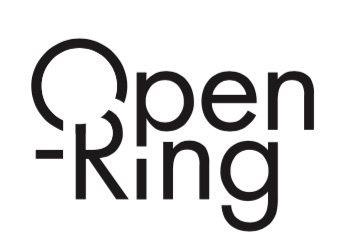First written in french, english version is following.
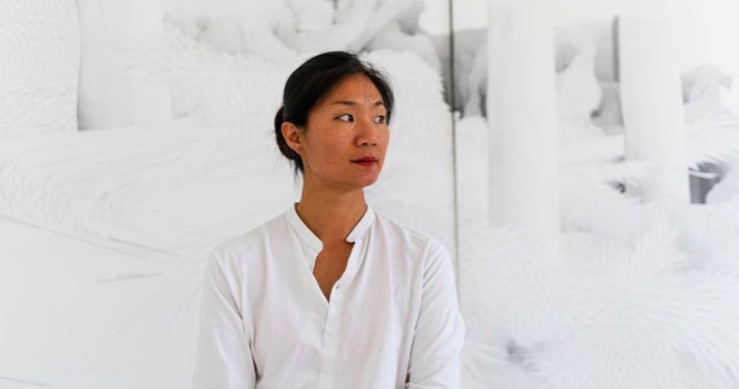
Etre artiste ce n’était pas une décision, j’ai une activité créative quotidienne depuis que je suis toute petite. Je ne me suis même pas posée la question de devenir autre chose, c’était dans les veines. Après je dirais que ma première oeuvre remonte à 2003, quand j’étais en fin d’études aux Beaux-Arts de Paris. Parce que j’ai eu le sentiment de pouvoir communiquer quelque chose aux autres, et que je dépassais le cadre de ma vie quotidienne ou de la thérapie du moi, de la recherche d’identité . Bref j’agrandissais mon territoire.
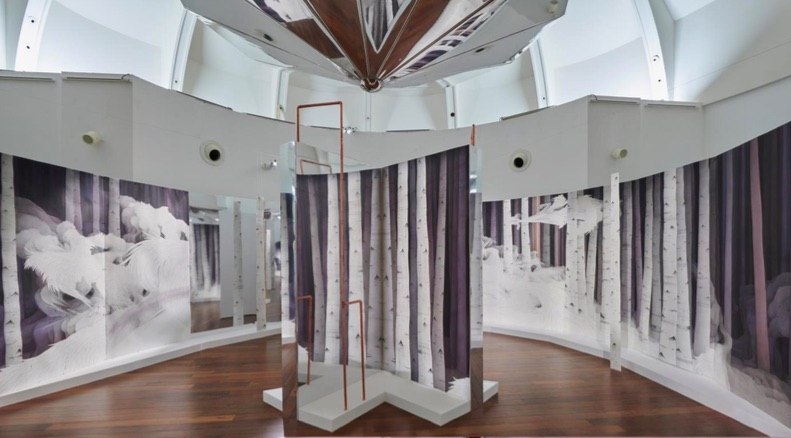
Min Jung-Yeon est née en 1979 à Gwangju, République de Corée.
Elle a grandi dans la campagne sud-coréenne où dès le plus jeune âge elle s’est immergée dans la nature. En 1997, elle part à Séoul pour se former aux arts plastiques à l’Université Hongik. Après ses études, elle éprouve le besoin de se confronter à d’autres modes de pensée ; Min Jung-Yeon quitte la Corée pour intégrer les Beaux-Arts de Paris et l’atelier de Jean-Michel Alberola, dont elle sort diplômée en 2006. Depuis, installée en France, à Toulon, elle poursuit une œuvre empreinte de tensions, comme son pays d’origine la Corée contemporaine toujours coupée en deux, qu’elle réconcilie par son art. En 2019, le Musée national des arts asiatiques – Guimet (Paris) lui offre une carte blanche. Exposée régulièrement en Asie et en Europe depuis 2004, elle collabore avec la Galerie Maria Lund à Paris depuis 2010 qui lui consacre une exposition monographique du 13 Mars au 9 Mai 2020.
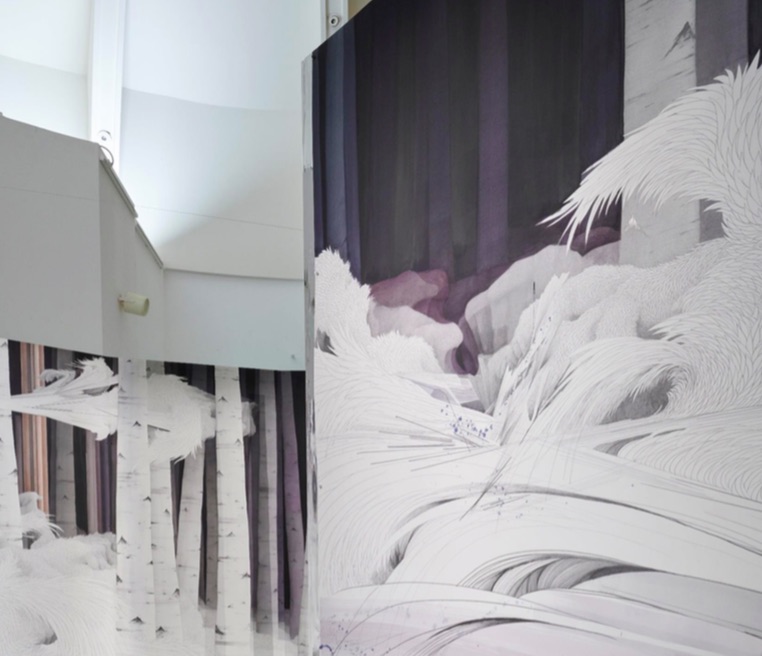
Oui au Musée Guimet en plus de mon installation j’ai souhaité présenter la collection de mon père, ses pierres de lettrés. Elles ont joué un rôle important dans mon parcours. Enfant j’allais les chercher avec lui le week-end, comme une chasse au trésor. Il m’a appris comment les voir, les choisir, de quelle façon on peut définir la beauté, celle qu’on ne fait pas mais que l’on cherche. C’est la philosophie de cette collection qui reste importante pour moi aujourd’hui.
Cette pensée s’inspire du taoïsme, qui d’ailleurs à la différence du Confucianisme, pose une égalité totale entre l’homme et la femme. Dans cette philosophie on cherche un élément extérieur, en l’occurence la pierre, pour compléter un intérieur, et donc démolir la séparation entre les deux. C’est ce que j’essaie aussi de faire dans mon travail entre la 2D et la 3D, ou le miroir comme la pierre démolit la séparation entre les deux, les réconcilie. Le but de la réconciliation c’est de trouver l’harmonie à plusieurs niveaux. Dans mon travail j’utilise le contraste, la tension en gardant et acceptant les différences sans les mélanger : le réel et l’irrationnel, le figuratif et non figuratif, dessin au crayon papier et acrylique dilué, 2D et 3D, et dernièrement la fulgurance ou la violence du geste et la douceur.
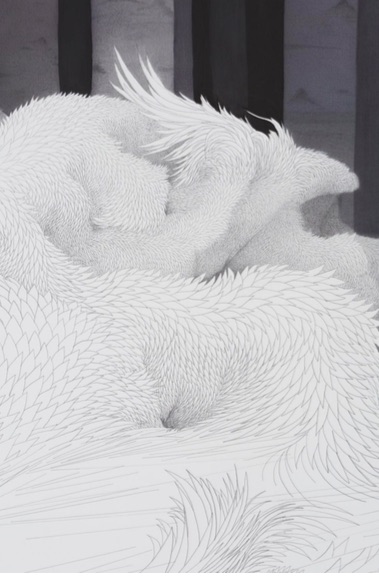
Tu m’interroges sur la présence de plumes dessinées dans mon travail. L’oiseau en Asie est le médium entre la terre et le ciel. Selon le rituel funéraire chamanique coréen, il nettoie la route pour l’esprit de la mort afin qu’il puisse passer au ciel. Je garde un souvenir d’enfance où j’ai vu cette femme chamane danser avec un costume blanc en plumes, les plumes n’étaient pas réelles mais découpées dans du papier blanc, elle devenait un pur objet abstrait. Dans mon travail c’est comme si avec ces dessins de plumes je purifiais l’espace que j’ai longtemps vécu comme obscur.
Dans le taoïsme, dans le livre de Zhuāngzǐ de Tchouang Tseu, il y a un poisson qui voulait devenir un oiseau pour pouvoir s’envoler. Il a pris beaucoup de temps pour transformer chacune de ses écailles en plumes. Mais il était tellement gros qu’il n’avait plus assez de place sur terre pour pouvoir décoller, comme dans le poème L’Albatros de Baudelaire. Il attendait l’aide d’une tempête pour y parvenir, il était Yin il voulait devenir Yang. C’est toujours des histoires de circulation d’énergie entre les deux pôles , entre la joie et la douleur aussi. En même temps, tu es les deux, comme chaque être est homme et femme à la fois. Comme l’oiseau est énorme, tu ne vois pas la totalité, un peu comme les rhizomes de Deleuze, la forme s’auto-génère et on ne sait pas où elle commence et où elle s’arrête. C’est cette sensation que j’ai voulu faire partager au Musée Guimet.
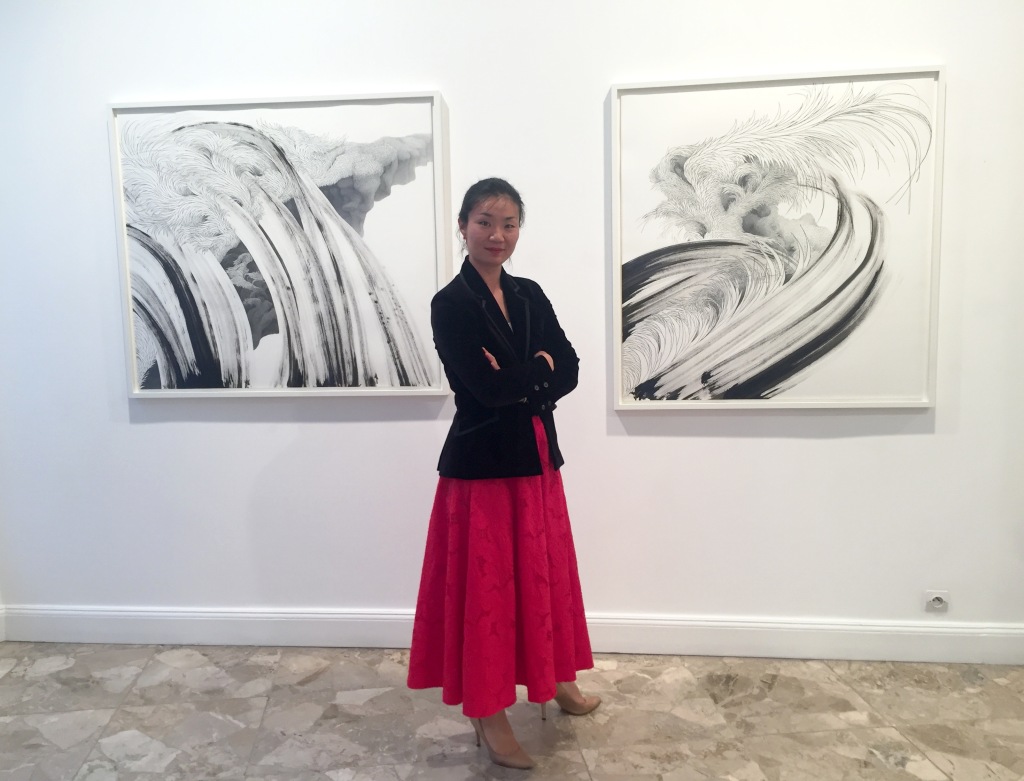
Maintenant j’arrive à revenir au geste de ma culture initiale, sa force, la légèreté et l’importance du vide. Ma mère était calligraphe, petite j’ai beaucoup pratiqué en m’amusant avec elle. Plus tard j’ai été fascinée par la précision et l’hyper réalisme de certaines peintures à l’huile européenne. Le peintre qui m’inspire le plus , et qui est très différent de moi c’est Francis Bacon. J’avais lu une interview de lui où le journaliste lui demandait pourquoi il avait voulu faire un pape horrible, Bacon avait répondu que lui le trouvait sublime. Je trouve cela très juste comme remarque et ça s’applique aussi à mon travail. Je partage aussi sa vision de la peinture où il démolit la différence entre l’espace et le figure, pour créer le « figural». Je cherche aussi le côté figural dans mon travail.
A l’avenir, je suis en train de mijoter des projets avec la musique et la danse contemporaines. Collaborer avec d’autres artistes crée une autre énergie, une nouvelle harmonie.
Interview réalisée par Valentine Meyer le 13 Mars, à la Galerie Maria Lund. https://marialund.com/fr/exposition-min-jung-yeon-laube-apres-la-nuit/
Min Jung-Yeon, the art of differences and reconciliation
“Being an artist wasn’t a decision; I have been artistically active since I was a child. I did not even ask myself if I wanted to become something else, it ran in my blood. I would say that my first artwork dates back to 2003, when I was finishing my studies at the Beaux-Arts in Paris. Because I had the feeling to be able to communicate something to others and that I outgrew the frame of my everyday life or of self-therapy, identity searching. In short, I was expanding my territory.”
Min Jung-Yeon was born in 1979 in Gwangju, Republic of Korea. She grew up in the South-Korean countryside where, from a very young age, she started observing and immersing herself in the surrounding nature. In 1997, she moved to Seoul to study fine art at the Hongik University. After her studies, she felt the need to confront herself with different ways of thinking; Min Jung-Yeon left Korea to attend the Fine Arts Academy in Paris (ENSBA) and the studio of Jean-Michel Alberola, which she graduated from in 2006. Since then, the artist has lived in France, in Toulon, and continues to create a body of work marked by tensions, mirroring her native country, contemporary Korea, still split in two, which she reconcilesthrough her art.
In 2019, the Musée National des arts asiatiques – Guimet (the National Museum of Asian Art, Paris) offered her a “carte blanche”. Regularly exhibited in Asia and in Europe since 2004, she has been collaborating since 2010 with the Galerie Maria Lund, which is presenting a monographic exhibition of her work from March 13th to May 9th 2020.
“Yes, at the Musée Guimet, in addition to my installation, I wanted to present my father’s collection of scholar rocks. They have played an important role in my career. As a child, I would go pick them with him on weekends, like a treasure hunt. He taught me how to see them, choose them, how to define beauty, the one that cannot be achieved but can be sought. It is the philosophy behind the collection that remains important to me today. This way of thinking draws inspiration from Taoism, which contrary to Confucianism, claims total equality between men and women. In this philosophy, one looks for an exterior element, here the rock, to complete an interior, and thus demolish the separation between the two. That is also what I try to do in my work between 2D and 3D, where the mirror, just like the rock, breaks the separation between the two, brings them to reconcile.
The aim of reconciliation is to find harmony on several levels. In my work, I use the contrast, the tension, by keeping and accepting differences without blending them together: the real and the irrational, the figurative and non-figurative, pencil drawing and diluted acrylic, 2D and 3D and recently the swiftness or violence of gesture as opposed to softness.
You just asked me about the presence of drawn feathers in my work. In Asia, birds are the vehicles between the heavens and earth. According to the Korean shamanic funerary rite, it clears the way for the spirit of death to be able to reach the sky. I still remember when, as a child, I saw this Shaman woman in a white costume made of feathers dancing, the feathers were not real but cut-out from white paper.She resembled a pure abstract object. In my work, it is as if I purified the space I often experienced as dark with my feather drawings. In Taoism, in the Zhuāngzǐ Book by Tchouang Tseu, there is a fish that wanted to become a bird, to fly away. It took the fish a lot of time to transform each of its scales into feathers. But it was so big that it didn’t have enough space on Earth to be able to fly off, like in Baudelaire’s poem, The Albatross. It waited for a tempest to help it do it, it was Yin and wanted to become Yang. There are always stories about energy circulation between the two poles, between joy and pain also. At the same time, we are both, just like every being is both man and woman. Because the bird is huge, we don’t see the totality, a bit like Deleuze’s rhizomes, the form self-generates and one doesn’t know where it starts and where it ends. It’s this sensation I wanted to share at the Musée Guimet.
Now I am able to go back to the gesture of my initial culture, its power, lightness and the importance of the void. My mother was a calligrapher; I had a lot of fun practicing with her when I was little. Later on, I was fascinated by the precision and the hyperrealism of certain European oil paintings. The painter that inspires me the most and who is very different from me is Francis Bacon. I read an interview of him where the journalist asked him why he had wanted to do a horrible pope, Bacon answered that he found him sublime. I find that remark very pertinent and it applies to my work as well. I also share his vision of painting where he destroys the difference between space and figure, to create the “figural”. I am also looking for the figural in my work.
In the future, I am planning projects with contemporary music and dance. Collaborating with other artists creates a new energy, a new harmony.”
Conversation with Valentine Meyer, March 13th 2020 at the Galerie Maria Lund. https://marialund.com/en/artists/min-jung-yeon/
Translated from French by Jessica Watson
